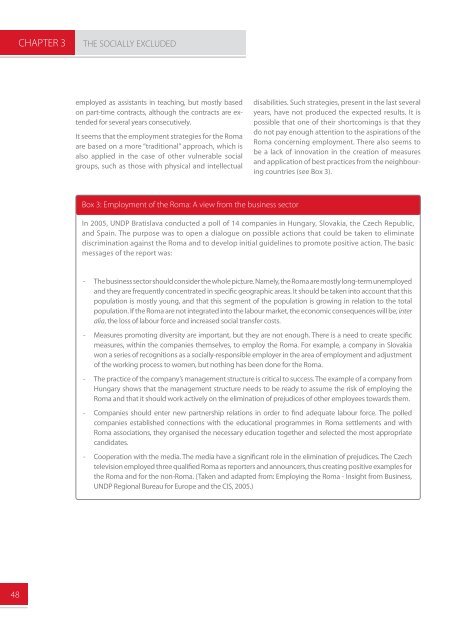THE SOCIALLY EXCLUDEDCHAPTER 3tives to children and parents to participate, and the inabilityto find employment upon finishing education.In regards to the education of the Serb national minority,in Podunavlje, there is a complete segregationof Serbs and <strong>Croatia</strong>ns, which is conducted under theshield of “the right to att<strong>end</strong> school in one’s mothertongue”. This situation is considered in the <strong>Croatia</strong>nlegal order of Erdut Accord on Peaceful Reintegrationof Podunavlje, and it is supported by the political eliteof both ethnic communities. In other Areas of SpecialState Concern, the greatest obstacle to integration ofchildren returnees in the <strong>Croatia</strong>n education systemis the accreditation of diplomas acquired duringtheir refugee status, mostly in Serbia and Bosniaand Herzegovina (Republika Srpska). In order tofind employment or continue secondary or tertiaryeducation, young returnees have to pass differentialexams in language and history. The rigidity of theseprocedures discourages younger families with childrenfrom returning.“They are both excellent students. When I think abouthow many possibilities they might have, but I cannotafford it... It is terrible.“ – these were the words of onereturnee who decided not to remain in <strong>Croatia</strong>. Returneesusually come back to live in isolated hamletswithout a supporting education infrastructure ormany school-age children. Due to poor socio-economicconditions, children of returnees have fewchances to continue with higher education, sincetheir families cannot afford to finance their studies inlarger cities.3.2.5 Access to Employment andEmployment Services“I called by phone to ask whether I could apply for ajob. They told me I could and when I got there, theyjust looked at me and told me they would contactme. We can’t find work, because we are black.Wherever you go, you’re a black sheep. I think thatonly two people from our village managed to finda job since 1990...” (Participants of the focus group,Sisak, <strong>UNDP</strong> 2006b)Up to 80.2% of the members of Roma householdsare unemployed, 16.7% of Roma are employed, and5% receive pension. Twenty-three percent of thepopulation generate temporary income by collectingsecondary raw materials, 20% perform seasonaljobs, and 4% do sales or minor repairs (Rogić, 2005).Two basic t<strong>end</strong>encies can be seen in this incomestructure. First, there is an extremely low percentageof individuals who manage to work long enoughto secure their pension. Second, because of theirinability to participate in the labour market, manyseek alternatives to the formal work, though mostlytemporary. The relatively high percentage of thosegenerating income from such sources may indicatethe high demand for such jobs, and the flexibilityof the Roma to fill this demand outside the formallabour market. However, these jobs do not securepermanent income or health and pension insurance,they do not guarantee respect and status amongstother members of the community, and they do notnurture interactions with the majority population.For the most part, women are not expected to findpaid employment, but paradoxically they are expectedto put food on the table. Patriarchal relationsare still very strong in some Roma communities andamongst the middle-aged and older generations. Theposition of young women and girls is especially unfavourable,because they are expected to get marriedat a relatively young age and are offered no alternatives.Considering very few finish secondary school,and those who graduate cannot find a job, marriageis the only option which provides a degree of respectin the community, even though in the familyhierarchy recently-wed women without children takethe lowest position. However, there is an increasingnumber of young Roma women, especially in urbanenvironments, such as Zagreb and Rijeka, whose lifeplans include education and employment.The measures contained in The National Programmefor the Roma and The National Action Plan for theDecade of Roma Inclusion relating to employment,emphasise the participation of the Roma in publicworks, seminars on additional education, incentivesto self-employment through trade and craft enterprises,and two-year subsidies to employers who employ theRoma. These measures are meant to boost the employabilityof the Roma, but it seems that the measures concerningpublic works do not include the componentsrelated to the elimination of prejudices. They may in factcontribute to the intensifying stereotypes, which portraythe Roma as only being capable of physical work.In the case of other measures, the plans to monitor therelationship of the employer towards the workers andtheir sustainability are unclear. In addition, the Roma are47
CHAPTER 3THE SOCIALLY EXCLUDEDemployed as assistants in teaching, but mostly basedon part-time contracts, although the contracts are ext<strong>end</strong>edfor several years consecutively.It seems that the employment strategies for the Romaare based on a more “traditional” approach, which isalso applied in the case of other vulnerable socialgroups, such as those with physical and intellectualdisabilities. Such strategies, present in the last severalyears, have not produced the expected results. It ispossible that one of their shortcomings is that theydo not pay enough attention to the aspirations of theRoma concerning employment. There also seems tobe a lack of innovation in the creation of measuresand application of best practices from the neighbouringcountries (see Box 3).Box 3: Employment of the Roma: A view from the business sectorIn 2005, <strong>UNDP</strong> Bratislava conducted a poll of 14 companies in Hungary, Slovakia, the Czech Republic,and Spain. The purpose was to open a dialogue on possible actions that could be taken to eliminatediscrimination against the Roma and to develop initial guidelines to promote positive action. The basicmessages of the report was:- The business sector should consider the whole picture. Namely, the Roma are mostly long-term unemployedand they are frequently concentrated in specific geographic areas. It should be taken into account that thispopulation is mostly young, and that this segment of the population is growing in relation to the totalpopulation. If the Roma are not integrated into the labour market, the economic consequences will be, interalia, the loss of labour force and increased social transfer costs.- Measures promoting diversity are important, but they are not enough. There is a need to create specificmeasures, within the companies themselves, to employ the Roma. For example, a company in Slovakiawon a series of recognitions as a socially-responsible employer in the area of employment and adjustmentof the working process to women, but nothing has been done for the Roma.- The practice of the company’s management structure is critical to success. The example of a company fromHungary shows that the management structure needs to be ready to assume the risk of employing theRoma and that it should work actively on the elimination of prejudices of other employees towards them.- Companies should enter new partnership relations in order to find adequate labour force. The polledcompanies established connections with the educational programmes in Roma settlements and withRoma associations, they organised the necessary education together and selected the most appropriatecandidates.- Cooperation with the media. The media have a significant role in the elimination of prejudices. The Czechtelevision employed three qualified Roma as reporters and announcers, thus creating positive examples forthe Roma and for the non-Roma. (Taken and adapted from: Employing the Roma - Insight from Business,<strong>UNDP</strong> Regional Bureau for Europe and the CIS, 2005.)48

















